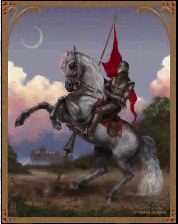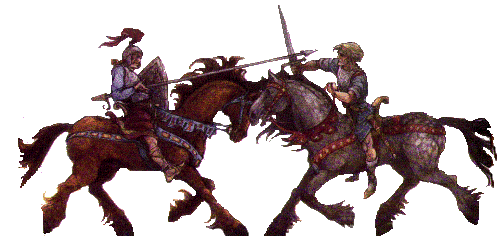 How
a Boy Becomes
How
a Boy Becomes
a
Knight

Many
a lady at some point in her life, dreams of a knight in shining armour
riding
up on his white steed and whisking her away to a world of romance
and
adventure. Just how did one become a knight in the middle ages?
The
following information leads you through the stages to knighthood.



Becoming
a Page

A
boy usually of nobility was chosen for knighthood, but not always.
A boy started on his way to knighthood at about the age of seven or eight.
At this
time,
he was sent to a Lord's castle to be trained for knighthood. This
young
trainee
was known as a page. During his time as a page, he learned about
horses,
armour and weapons. Because hunting was so important, a page
had
to learn how to handle hawks and falcons, as well as to cut up a deer
for
venison. Since a page was also expected to serve the
meals
at the knight's table, they had to learn how to carve the meat properly
before
becoming a knight.
Pages
practiced fighting with a sword against a wooden stake, or "pell" to develop
muscles needed in becoming a strong knight. A page had to learn to
skillfully use a
bow
and arrow for hunting and often practiced this skill by competing
with
others. Pages also had to clean the coats of mail by rolling it
in
a barrel filled with sand.
A
knight not only had to know how to fight in battle, but he also had to
learn how
to
be courteous. The lady of the castle taught a young page manners
and social graces. He would learn how to sing, play instruments and
dance from the lady. The lady would also teach him to read and write.
A
priest would give the page religious training and he would often teach
the page how to read and write.

Becoming
a Squire

At
the age of fourteen the page became a squire. Squires had to follow
their
master on the battlefield to protect him if he would fall. From the
13th century,
squires
fought on the battlefield beside their knight.
A
squire was responsible for dressing the knight for battles and tournaments.
He
was the knight's assistant and the only one allowed to help the knight.
The
squire was responsible for taking care of the knight's armour and weapons.
He
had to become skilled in the use of the armour as well as the weapons.
A
squire had to get used to wearing the armour so it would be second
nature
to him when worn.
A
squire had to become skilled in using the lance, spear, or sword.
He had to practice so that the lance did not run back through his fingers
when he struck the knight. He practiced against a wooden dummy
called a quintain. A quintain was a heavy weighted sack or dummy
in the form of a human. It was hung on a wooden pole along with a shield.
The squire had to hit the shield in it's center. When hit, the whole structure
would spin around and around. The page had to move out of the way quickly
without getting hit and knocked off his horse by the weighted bag!

Becoming
a Knight

When
considered ready, generally between the ages of eighteen and twenty, a
squire was dubbed a knight. This was often performed by the
knight who trained him. On the eve before becoming a knight, the
squire confessed his sins to a priest. He was given a symbolic bath
and then he fasted, cleansing his soul. Dressed all in white he prayed
and kept watch over his armour and his weapons in the chapel all night.
The next morning he would be dressed in symbolically colored clothes -
red (for his blood), white (for purity), and brown (for the return to the
earth when he died). Gilded spurs were attached to his ankles and
he was "girded" with a sword. By a tap on each shoulder with a sword,
he was dubbed a knight, thus reminding him of his vows he promised to uphold.
If a knight broke his vows or was dishonorable, he was stripped of his
knighthood in another ceremony to bury him, because in the Middle Ages,
" a knight without honour is no longer alive."


There
were two other ways for one to become a knight. If there was a battle
and the King needed additional men, he would knight a number of squires
to have enough men to fight. Also, one could become a knight for
showing bravery and courage in battle.




Tournaments


Jousts






 How
a Boy Becomes
How
a Boy Becomes
![]()

![]()
![]()





